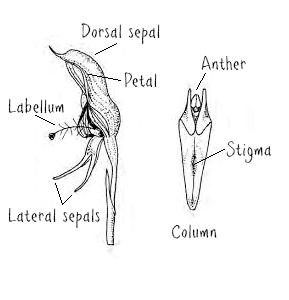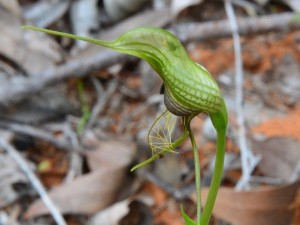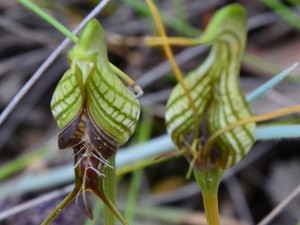The Secret Sex Life of Western Australia’s Wildflowers – the Bird Orchid

The Secret Sex Life of Western Australia’s Wildflowers – the Bird Orchid
Posted on
All’s fair in love and war
Honesty is not a desirable trait among many of our orchid friends and sexual deception of all kinds is rife among the 411 known species of Western Australian orchids. It’s not about push-up bras and horrible control briefs though – orchids have taken the seduction game to a whole new level. Here’s how our Bird Orchids (Pterostylis barbata and P.turfosa) do it…
Sex, lies and pheremones
Bird orchids attract their specific pollinator, a tiny gnat, by emitting a scent from a little pouch at the end of their labellum (you can see the pouch clearly in the diagram to the left and less clearly in Simon’s top left photo). Some say it is the scent of the gnat’s favourite food – a delicious fungus which no gnat can resist. Others say the orchid releases a smell that is identical to the sex-attractant scent (or pheremone) that the female gnat releases, attracting virile young male gnats from far and wide.
Whether it’s sex or food that draws the gnat to the Bird Orchid, once it arrives there is little it can do to escape the clutches of the procreation-focused flower.
The gnatty gritty of getting a Bird Orchid up the duff
The hungry or horny gnat flies in and lands on the hairy looking labellum of the orchid, keen to find the source of the enticing smell that has lured it there. As it looks around and sees neither fungi buffet nor hot-to-trot lady gnat, perhaps Mr Gnat starts to suspect something is amiss. To late though.
Quick as a flash the labellum, which is very sensitive to touch, springs up, pushing the unsuspecting gnat inside a mysterious enclosed chamber. The chamber is formed by the orchid’s petals and dorsal sepal, which are fused together. I imagine it’s quite a nice place to be for a gnat – quiet, with a green glow coming through the translucent chamber walls. Inside the chamber is the column, where the sex organs of the orchid are strategically arranged.
The labellum remain engaged, blocking an escape by the gnat back the way it came. And so it is forced to crawl up along the enclosed column toward the Bird Orchid’s “beak”. First the gnat passes the sticky stigma (female organ) where any pollen it might have picked up from other orchids is deposited. Then the gnat passes the anthers (male organs) where it picks up a fresh batch of pollen to take onto the next orchid. You can see where the orchid keeps its pollen in the top left photo – like a little yellow eye.
Once it’s duties are done, the gnat emerges, probably feeling a little disappointed, from the top of the chamber. Perhaps next time he’ll get what he’s looking for…
If you’re walking in the south west of Western Australia in late winter or spring, keep an eye out for Bird Orchids and other Pterostylis species. They are found from Perth to Albany but you’ll need to have your Orchid Eyes engaged as they can be hard to spot! Have you seen a Bird Orchid lately? Tell us in the comments below.





